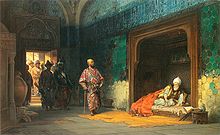Battle of Angora
The battle of Angora or battle of Ankara was fought on July 20, 1402 between Beyazid I (Bayezid the Lightning), sultan of the Ottoman Empire, and Tamerlane (Temür), in the Çubuk plain, northeast of the city of Ankara, in Anatolia (present-day Turkey).
Background
By this time, the Ottoman Empire had almost completed its conquest of the former domains of the Byzantine Empire, inflicting heavy defeats on Serbia and the Frankish Crusader Knights. Tamerlane, for his part, had used his domains near Samarkand to create an empire for himself that stretched from Russia to China. In his overwhelming invasion of the Middle East, he inevitably had to measure forces with the Ottomans, the main political referent in the area.
Beyazid had made what later proved to be a mistake: in 1400, he tried to impose his suzerainty on the emir Taherten, a subject of Temür (who held him in high esteem for his work as guardian of his borders in Asia Minor, about to of having given him an elephant that he had captured in his campaign to India), who ruled in Erzincan and Erzurum. To do this, Beyazid used Qara Yusuf, head of the Black Sheep horde and Temür's enemy. In support of his vassal, Temür headed for Asia Minor in August 1400. But while Temür was at war with the Mamluks in Syria, Beyazid took Erzincan, capturing Taherten's family. Temür did not immediately retaliate, spending the winter of 1401-1402 in Karabakh, and the spring of 1402 on the borders of Georgia, finally invading the Ottoman Empire in June 1402. He restored Taherten at Erzincan, clothed his troops on the Sivas plain and, by way of Kayseri, headed towards Ankara, where his enemy was.
The Battle
The battle lasted from six in the morning until nightfall, and according to chroniclers of the time, it involved close to a million men. This figure seems exaggerated, but considering the troop availability of both rivals, it is reasonable to estimate at least that between 400 and 500 thousand soldiers participated in the battle. Beyazid had brought contingents from all the conquered peoples. But while the Serbs and their king Stefan remained loyal, thus repaying a debt of honor incurred in the treaties after the battle of Kosovo, the Turks of Aydin, Mentese, Saruhan and Kermian, seeing their princes among Temür's forces, they switched sides. Temür seems to have made very good use of the elephants he had brought from India.
The Turco-Mongolian army, located upstream of the Çubuk stream (which flows from the current village of the same name towards Ankara), managed (according to Turgut Dincer) through an engineering work to divide the waters of the stream, depriving the Ottoman army of water. Temperatures on the Anatolian plateau, in the height of summer, reach and exceed 35.o C, and the Ottoman commanders were forced to try to recover the water supply, which facilitated an encircling movement of Temür's troops, devastating the flanks of the adversary.
Beyazid fought all day, at the head of 10,000 Janissaries and Serb troops. Finally, at sunset he decided to withdraw after seeing his guard wiped out. But his horse fell dead and he was taken prisoner along with one of his sons.
Consequences
Beyazid, humiliated by the disaster (some historians say that it was used by Tamerlane as a footstool on which to rest his feet to mount his horse), would die shortly after (1403). Temür will continue his campaign in Asia Minor, razing the Ottoman capital, Bursa and the Christian enclave of the Knights of Rhodes in Smyrna. Ottoman territory experienced a severe shakeup, being reduced to little more than northern Phrygia, Bithynia and Mysia, the Balkans, and what remained of the Byzantine Empire. For his part, Tamerlane desisted from continuing to attack the Ottoman domains, and embarked on an expedition to China, in which he perished, dismembering his empire, so that the threat that he posed to the Ottomans disappeared forever.. In any case, it took the Ottomans at least a couple of decades to recover from the blow they received.
Contenido relacionado
Spanish colonization of America
Ancient Greece
Miyamoto Musashi
